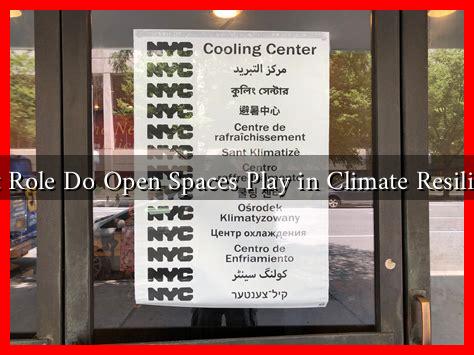-
Table of Contents
- What Role Do Open Spaces Play in Climate Resilience?
- The Importance of Open Spaces in Urban Environments
- Case Studies: Successful Implementation of Open Spaces
- 1. New York City’s Green Infrastructure
- 2. Singapore’s Park Connector Network
- 3. Melbourne’s Urban Forest Strategy
- Statistics Highlighting the Benefits of Open Spaces
- Challenges and Considerations
- Conclusion
What Role Do Open Spaces Play in Climate Resilience?
As urbanization continues to rise, the importance of open spaces in cities has become increasingly evident, particularly in the context of climate resilience. Open spaces, which include parks, greenways, and natural reserves, serve as vital components in mitigating the impacts of climate change. This article explores the multifaceted roles that open spaces play in enhancing climate resilience, supported by relevant examples and statistics.
The Importance of Open Spaces in Urban Environments
Open spaces are essential for maintaining ecological balance and providing numerous benefits to urban populations. They serve as lungs for cities, improving air quality and providing recreational opportunities. However, their role extends far beyond aesthetics and leisure. Here are some key functions of open spaces in urban settings:
- Carbon Sequestration: Trees and vegetation absorb carbon dioxide, a major greenhouse gas, thus helping to mitigate climate change.
- Stormwater Management: Open spaces can absorb rainwater, reducing runoff and the risk of flooding.
- Temperature Regulation: Green areas help lower urban temperatures, combating the urban heat island effect.
- Biodiversity Support: Open spaces provide habitats for various species, promoting biodiversity and ecosystem health.
Case Studies: Successful Implementation of Open Spaces
Several cities around the world have successfully integrated open spaces into their climate resilience strategies. Here are a few notable examples:
1. New York City’s Green Infrastructure
New York City has implemented a comprehensive green infrastructure plan that includes the creation of green roofs, rain gardens, and expanded park spaces. According to the NYC Department of Environmental Protection, these initiatives have reduced stormwater runoff by over 1.5 billion gallons annually, significantly decreasing the risk of flooding during heavy rainfall.
2. Singapore’s Park Connector Network
Singapore has developed an extensive network of parks and green corridors that connect urban areas with nature. This initiative not only enhances biodiversity but also provides residents with access to green spaces, promoting mental well-being. The city-state aims to have 85% of its residents within a 400-meter walk of a park by 2030, demonstrating a commitment to integrating nature into urban life.
3. Melbourne’s Urban Forest Strategy
Melbourne has launched an Urban Forest Strategy aimed at increasing tree canopy cover to 40% by 2040. This initiative is designed to combat the urban heat island effect and improve air quality. The city has reported a decrease in average temperatures in areas with increased tree cover, showcasing the effectiveness of urban forestry in climate resilience.
Statistics Highlighting the Benefits of Open Spaces
Research has shown that open spaces provide significant benefits in terms of climate resilience:
- A study by the Nature Journal found that urban green spaces can reduce city temperatures by up to 5°C.
- The U.S. Environmental Protection Agency estimates that green infrastructure can reduce stormwater runoff by 30-50% in urban areas.
- According to the World Health Organization, access to green spaces is linked to improved mental health outcomes, reducing stress and anxiety levels.
Challenges and Considerations
While the benefits of open spaces are clear, there are challenges to their implementation:
- Land Use Conflicts: In densely populated cities, finding space for new parks can be difficult.
- Maintenance Costs: Open spaces require ongoing maintenance, which can strain municipal budgets.
- Equity Issues: Access to open spaces is often uneven, with marginalized communities frequently lacking adequate green areas.
Conclusion
Open spaces play a crucial role in enhancing climate resilience in urban environments. They provide essential ecological services, improve public health, and contribute to the overall quality of life for residents. As cities continue to grapple with the impacts of climate change, investing in and prioritizing open spaces will be vital for sustainable urban development. By learning from successful case studies and addressing the challenges associated with open space implementation, cities can create greener, more resilient futures for their inhabitants.

